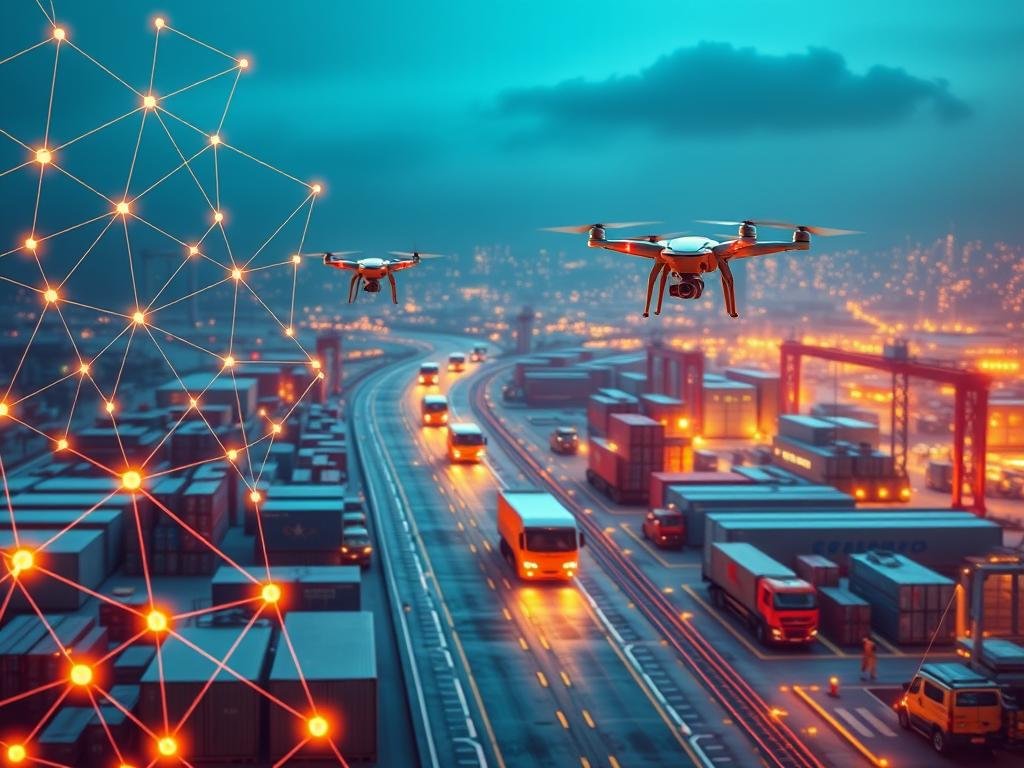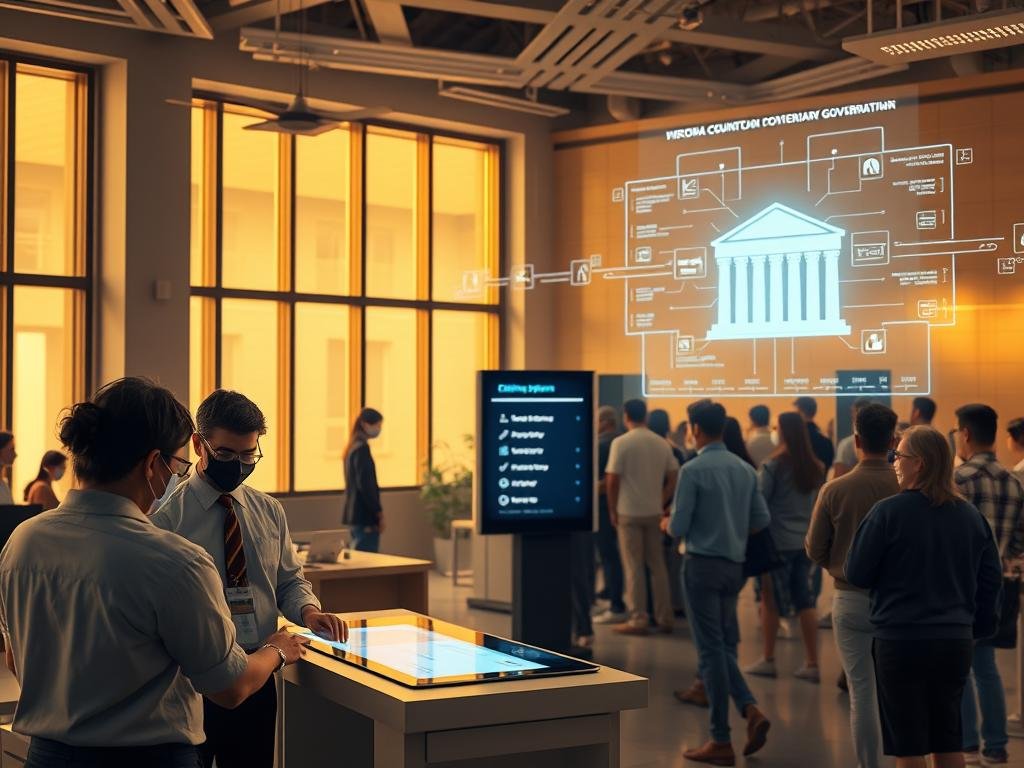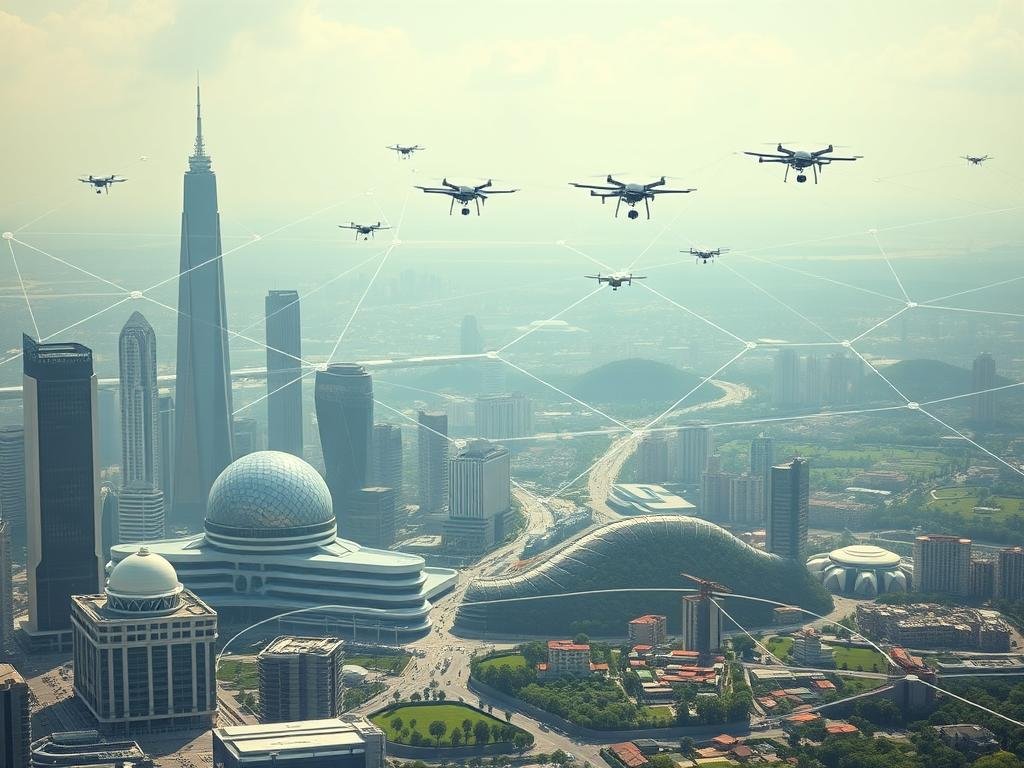The global blockchain market is expected to hit $69.7 billion by 2025. This growth is thanks to blockchain’s increasing use in areas beyond digital money. It’s changing how we manage supply chains and even healthcare.
Beyond its financial roots, blockchain is becoming a game-changer. It brings better security, clearness, and speed. This piece looks at 12 blockchain applications that are changing industries. They’re leading us towards a more open future.
Key Takeaways
- Blockchain technology is transforming industries beyond finance.
- The global blockchain market is projected to reach $69.7 billion by 2025.
- 12 blockchain applications are highlighted for their industry impact.
- Blockchain offers enhanced security, transparency, and efficiency.
- Adoption roadmaps and implementation costs are key for success.
The Evolution of Blockchain Technology Beyond Digital Currencies
Blockchain technology has changed a lot, moving from digital currencies to business uses. It started with Bitcoin but now helps many industries. This change has transformed how businesses work.
From Bitcoin to Business Solutions: A Brief History
Blockchain was first used with Bitcoin in 2009. Soon, people saw its value beyond digital money. Businesses started using blockchain for its secure and efficient ways to solve problems.
Smart contracts on Ethereum made blockchain even more useful. They allow contracts to run on their own, with rules set in code.
Why Enterprises Are Embracing Blockchain in 2025
In 2025, companies love blockchain for good reasons. They want better security and transparency in their work. Blockchain’s unique setup is perfect for keeping data safe and sound.
| Industry | Blockchain Benefits | Potential Applications |
|---|---|---|
| Supply Chain | Enhanced transparency and traceability | Product tracking, inventory management |
| Finance | Secure and efficient transactions | Cross-border payments, settlements |
| Healthcare | Secure patient data management | Medical records, drug traceability |
Blockchain is getting better and will help even more areas. It’s leading to new ideas and better ways of doing things in many fields.
Understanding Enterprise Blockchain Solutions and Their Value Proposition
Blockchain is more than just cryptocurrency. It’s about creating strong, business-focused solutions. These solutions bring real value to organizations.
Enterprise blockchain solutions offer many benefits. They increase transparency, security, and efficiency. They are made for businesses, helping with secure data management and transactions.
Key Differences Between Public and Private Blockchain Networks
Blockchain technology has two main types: public and private networks. Public blockchains are open, letting anyone join in, like Bitcoin or Ethereum. On the other hand, private blockchains are closed, used by companies for internal use or in a controlled group.
| Feature | Public Blockchain | Private Blockchain |
|---|---|---|
| Access | Open to anyone | Restricted to authorized entities |
| Transaction Visibility | Transparent to all participants | Limited visibility to authorized parties |
| Scalability | Often slower due to consensus mechanisms | Potentially faster due to fewer nodes |
The Business Case for Blockchain Implementation
Implementing blockchain makes sense for businesses. It offers efficiency, cost savings, and security. It’s used in many fields, from supply chains to finance.
Businesses gain from blockchain in many ways:
- Increased Transparency: Immutable records offer a clear audit trail.
- Enhanced Security: Decentralized data storage lowers the risk of failure.
- Improved Efficiency: Smart contracts and automated processes make things smoother.
As more businesses use blockchain, its value will grow. This will lead to more adoption and new ideas.
Blockchain Business Applications: The12 Industry Transformations of2025
Blockchain technology is set to change many industries in 2025. It brings new solutions and clear transparency. Companies are now focusing on big blockchain ROI gains.
Selection Criteria for High-Impact Use Cases
Businesses need to pick the right blockchain use cases. They should look for ones that match their goals. Important criteria include:
- Potential for big cost savings or more money
- Ability to make operations better or clearer
- Scalability and how easy it is to set up
- How well it fits with current business systems
By focusing on these, companies can find blockchain uses that promise the best blockchain implementation guide and ROI.
Implementation Considerations Across Industries
Using blockchain needs careful thought about rules, working with others, and growing. Industries like supply chain, healthcare, and finance are using it to innovate and work better. For example, companies like Walmart and Maersk are using blockchain to make supply chains clearer and safer.
For a good blockchain use, businesses should:
- Make a detailed blockchain implementation guide for their needs
- Work with others in the industry for better working together
- Put money into blockchain that can grow with them
- Keep checking if blockchain is really working well
By knowing these steps and using AI and machine learning, companies can really make the most of blockchain. This will lead to big changes in their fields.
1. Supply Chain Management: End-to-End Transparency and Traceability
Supply chain management is changing fast with blockchain technology. Enterprise blockchain solutions bring transparency and traceability. This cuts down on counterfeits and boosts efficiency.

Implementation Costs and ROI Expectations
Starting a blockchain project in supply chain management can cost a lot. But, the benefits are huge. You’ll save money and work more efficiently. Here’s a look at what you might spend and what you could gain:
| Cost Component | Initial Investment | Ongoing Costs |
|---|---|---|
| Technology Infrastructure | $100,000 | $10,000/year |
| Development and Integration | $200,000 | $20,000/year |
| Training and Support | $50,000 | $5,000/year |
As Forbes points out, “Blockchain is making supply chains more open and less prone to fraud.” (
“Blockchain has the power to change supply chains by giving everyone a clear, unchangeable truth.”
)
Real-World Success Stories: Walmart and Maersk
Walmart and Maersk have made blockchain work in their supply chains. Walmart tracks its produce with blockchain to keep food safe. Maersk uses blockchain to make its global trade smoother.
- Walmart’s blockchain-based produce tracking system
- Maersk’s blockchain-enabled global trade platform
Adoption Roadmap for Supply Chain Blockchain Integration
To use blockchain in supply chain management, follow these steps:
- Check your supply chain and find areas to improve.
- Make a strong case for using blockchain, including cost savings.
- Pick a blockchain platform and find tech partners.
- Start with a small test to see how it works and make adjustments.
- Expand the use of blockchain across your company.
Learn more about blockchain and its uses at Digital Vista Online.
2. Healthcare Revolution: Secure Patient Data Management and Drug Traceability
The healthcare world is changing fast with blockchain technology. It helps keep patient data safe and track drugs. This makes healthcare better, more open, and more efficient.
Implementation Costs and ROI Expectations
Starting blockchain in healthcare costs money. You need new tech, to move data, and to train staff. But, it can save a lot of money. It can cut down fraud, make things more compliant, and work better.
When you look at the costs, you see a few main parts:
- Building the tech infrastructure
- Moving and joining data
- Teaching staff
- Keeping it all running
Real-World Success Stories: MediLedger and Patientory
Some companies are leading the way with blockchain in healthcare. MediLedger tracks drugs to stop fake ones. Patientory makes a safe place for patient data, helping care work better together.
These examples show how blockchain can solve big problems in healthcare. It makes data safe and supply chains clear.
Adoption Roadmap for Healthcare Blockchain Integration
Healthcare groups wanting to use blockchain need a plan. Here’s what to do:
- Find where blockchain can help, like with patient data or drug tracking.
- Make a plan with timelines, budgets, and who to involve.
- Work with tech companies, rules makers, and others in the field.
- Keep checking how well it works and change things as needed.
With a good plan, healthcare can use blockchain to its fullest. This can make a big difference.
3. Non-Crypto Blockchain Uses in Manufacturing and IoT Integration
Blockchain is changing how companies manage quality, track production, and do maintenance. It makes systems more open, safe, and efficient. This helps improve product quality and cuts costs.

Quality Control and Production Tracking
Blockchain lets us track production in real-time. This ensures products are up to standard. It also helps find and fix quality problems fast.
Blockchain helps prove products are real, cutting down on fake goods. For example, Bosch uses it to track parts, ensuring they’re genuine and of good quality.
| Benefits | Description |
|---|---|
| Improved Quality Control | Real-time monitoring and tracking of production processes |
| Enhanced Transparency | Immutable record of production stages |
| Reduced Counterfeiting | Authentication of products through blockchain |
Smart Manufacturing with Blockchain-Enabled IoT
Blockchain and IoT are changing smart manufacturing. They make production safer and more efficient.
IoT devices with blockchain can talk securely. This automates tasks and keeps data safe. It also lets smart contracts handle payments and other deals.
Key advantages of blockchain-enabled IoT in manufacturing include:
- Enhanced security through decentralized data storage
- Improved efficiency through automated processes
- Increased transparency through real-time monitoring
Predictive Maintenance and Supply Chain Integration
Blockchain helps with predictive maintenance. It analyzes IoT data to predict equipment failures. This cuts downtime and boosts efficiency.
Blockchain also improves supply chain management. It tracks goods and materials in real-time. This makes supply chains more visible and reduces delays or losses.
Predictive maintenance with blockchain and IoT saves money and boosts productivity. Companies like GE Appliances are using it to better their maintenance and cut costs.
4. Financial Services Transformation: Banking, Insurance, and Compliance
Blockchain is changing banking, insurance, and compliance. It makes these areas more secure, transparent, and efficient. Financial institutions are using blockchain to improve their operations.
Cross-Border Payments and Settlements
Blockchain is making cross-border payments faster, cheaper, and safer. Old payment systems are slow and expensive because they involve many middlemen. Blockchain can settle transactions instantly, cutting costs and fraud risks.
Key benefits of blockchain in cross-border payments include:
- Reduced transaction costs
- Increased speed of settlement
- Enhanced security and transparency
- Improved compliance with regulatory requirements
Smart Contracts for Insurance Claims Processing
Smart contracts are used in insurance to speed up claims. They are self-executing contracts that automatically pay out when conditions are met. This makes claims processing faster and reduces disputes.
The use of smart contracts in insurance claims processing offers several advantages, including:
- Automated claims processing
- Reduced administrative costs
- Increased transparency and trust
- Improved customer satisfaction
Know Your Customer (KYC) and Anti-Money Laundering (AML) Solutions
Blockchain helps with KYC and AML by creating a shared, unchangeable record of customer identity. This makes KYC checks simpler and cheaper. It also helps spot suspicious transactions better, improving AML efforts.
The benefits of blockchain in KYC and AML include:
- Improved identity verification
- Reduced costs associated with KYC checks
- Enhanced detection of suspicious transactions
- Increased collaboration between financial institutions
5. Government and Public Services: Voting, Identity, and Property Registry
Government agencies are using blockchain technology to make public services better. This includes voting and checking identities. It’s changing how governments work, making things more open, safe, and efficient.
Blockchain-Based Voting Systems and Citizen Identity Management
Blockchain is becoming popular for voting systems because it makes elections secure and open. It creates a permanent record of votes, cutting down fraud risks. For example, Estonia lets people vote online safely using blockchain.
Blockchain is also used for managing citizen identities. It helps create secure digital identities. This lets people control their data and prove who they are for government services. It makes services better and safer.

Property and Land Registry Transformation
Blockchain is changing property and land registries too. It helps cut down fraud and makes property deals faster. It creates a clear record of who owns what, solving disputes and speeding up property transfers.
Sweden and India are starting blockchain projects for land registries. They want to make sure land records are safe and clear. This will help fight fraud and make property deals more open.
Tax Collection and Compliance Monitoring
Blockchain can also help with taxes. It makes it easier to track money and catch tax cheats. This helps governments make sure everyone pays their fair share.
Blockchain can also make paying taxes easier. It makes it simpler for people and businesses to follow tax rules. This can bring in more money for governments and save them money too.
6. Retail and Consumer Applications: Authenticity, Loyalty, and Traceability
In the retail world, blockchain fights counterfeiting, boosts customer loyalty, and tracks products. It shows blockchain’s value beyond just money.
Luxury Goods Authentication and Anti-Counterfeiting Measures
Blockchain helps prove luxury items are real, cutting down on fake goods. For example, LVMH uses it to track their products. This way, buyers know they’re getting the real deal.
Counterfeit luxury goods cost the world billions each year. Blockchain creates a permanent record of a product’s journey. This stops fake items from slipping through.
Blockchain-Based Loyalty Programs and Customer Engagement
Retailers use blockchain to make loyalty programs better. It lets customers earn and use rewards across different brands. This makes loyalty programs more unified and rewarding.
For instance, blockchain-based loyalty programs let customers see and manage their rewards easily and safely.
Farm-to-Table Food Traceability for Consumer Trust
Blockchain helps track food from farm to table. This ensures food is safe and genuine. It builds trust with consumers.
As
“The use of blockchain in food traceability is a game-changer, enabling consumers to make informed decisions about the food they buy.”
This method also helps spot and fix food safety problems fast. It’s a win for everyone.
7. Energy Sector Transformation: Trading, Certification, and Grid Management
Blockchain is changing the energy sector in big ways. It’s making trading, certification, and grid management more efficient, transparent, and secure. This is a big deal for the energy industry.
Decentralized Energy Trading Platforms
Blockchain is helping create new energy trading platforms. These platforms let people and businesses trade energy directly with each other. This is thanks to smart contracts that make transactions secure and easy.
For example, Power Ledger and WePower are leading the way in blockchain energy trading. They help connect energy producers and consumers, boosting renewable energy and cutting down on traditional grid use.
| Platform | Features | Benefits |
|---|---|---|
| Power Ledger | P2P energy trading, blockchain-based | Promotes renewable energy, reduces grid reliance |
| WePower | Green energy trading, smart contracts | Enhances energy trading efficiency, transparency |
Renewable Energy Certification and Carbon Credits
Blockchain is also used for renewable energy certificates and carbon credits. It creates a secure record of renewable energy use. This makes it easier to trust and trade these credits.
MediLedger is working on blockchain for renewable energy tracking. This ensures that energy certificates are genuine and can’t be faked. It’s key for growing renewable energy and cutting carbon emissions.
Smart Grid Management and Optimization
Blockchain is also improving smart grid management. It allows for secure, real-time data sharing between grid operators and users. This makes energy distribution and use more efficient.
IoT devices monitor and control energy flow, with blockchain keeping data safe. This leads to better grid performance, less energy loss, and more reliability.
- Enhanced grid security through blockchain
- Real-time data exchange for optimized energy distribution
- Improved reliability and reduced energy losses
In conclusion, blockchain is changing the energy sector in many ways. From trading to grid management, it’s making things more efficient and secure. As blockchain evolves, we’ll see even more exciting changes in the energy industry.
Conclusion: The Future of Blockchain Industry Transformation Beyond2025
The future of blockchain technology looks bright for changing industries by 2025. Blockchain is set to change healthcare, supply chains, and finance. It’s making things more transparent, secure, and efficient.
For businesses, a good guide on using blockchain is key. By understanding blockchain, companies can lead the way and grab new chances. By 2025, over $27 billion will go into decentralized projects. The DeFi sector’s TVL is expected to grow three times.
Looking ahead, blockchain will keep pushing innovation and use in many fields. For more on blockchain’s real uses in 2025, check out Digital Vista Online. Blockchain solutions will be essential for the future, making operations secure, open, and smooth.
FAQ
What is blockchain technology, and how is it being used beyond cryptocurrency?
Blockchain is a digital ledger that records transactions on a network of computers. It’s used in many fields like supply chain, healthcare, and finance. It helps make things more secure, transparent, and efficient.
What are the key differences between public and private blockchain networks?
Public blockchain networks are open to everyone. Private networks are for a select group, often used by companies for privacy.
How is blockchain technology being used in supply chain management?
Blockchain helps track goods from start to finish. It makes it easier to verify and authenticate products. This improves supply chain efficiency.
What are the benefits of using blockchain technology in healthcare?
In healthcare, blockchain keeps patient data safe. It helps track drugs and improves health outcomes. It’s a secure way to manage medical records.
How is blockchain technology being used in manufacturing and IoT integration?
Blockchain enhances quality control and tracking in manufacturing. It works with IoT to monitor and optimize processes in real-time.
What are the applications of blockchain technology in financial services?
Blockchain makes cross-border payments and insurance claims easier. It ensures financial transactions are secure and transparent.
How is blockchain technology being used in government and public services?
Blockchain improves voting systems and identity management. It makes government operations more secure and efficient.
What are the benefits of using blockchain technology in retail and consumer products?
Blockchain ensures product authenticity and improves loyalty programs. It makes managing consumer data and products more secure and transparent.
How is blockchain technology being used in the energy sector?
Blockchain enables decentralized energy trading and renewable energy certification. It makes energy transactions more secure and efficient.
What is the future of blockchain industry transformation beyond 2025?
Beyond 2025, blockchain will see more innovation and adoption. It will enter new industries, driving growth and development.
Marcelo Miranda is a content editor and technology contributor at DigitalVistaOnline.com, specializing in digital literacy, tech tutorials, and online privacy. With a background in digital communication and SEO, he helps simplify complex tools for everyday users. Marcelo also supports content strategy and editorial planning, promoting clear, inclusive, and accessible tech knowledge for readers of all backgrounds.






